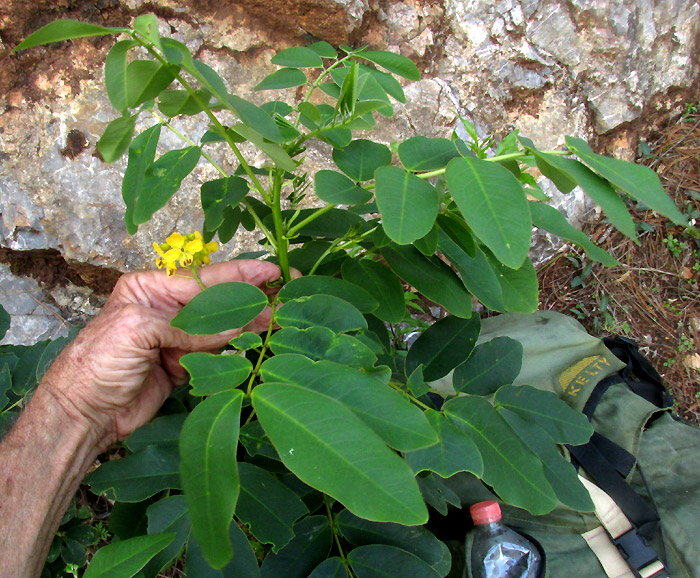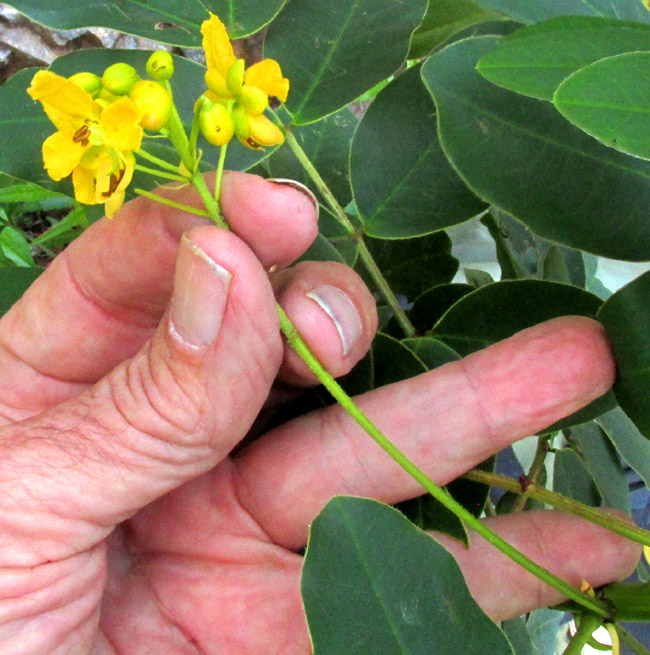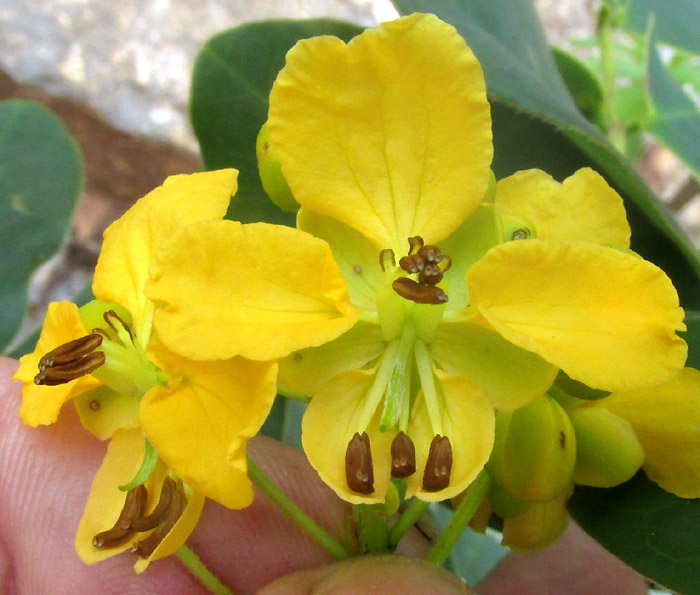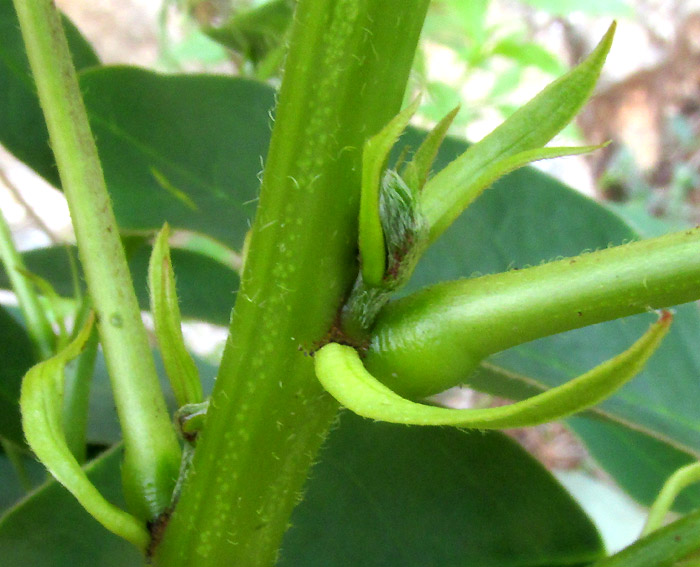Excerpts from Jim Conrad's
Naturalist Newsletter
Entry from field notes dated August 31, 2023, taken in Los Mármoles National Park in the Eastern Sierra Madre mountains, Hidalgo state, MÉXICO, along steeply climbing road heading eastward out of town of Trancas {on maps designated "Morelos (Trancas)"} toward Nicolás Flores; juniper/pine forest on limestone bedrock; elevation ~2,200m (~7,200ft); ~N20.80°, ~W99.25°
SENNA cf. PENDULA

At the beginning of my hike up the steep road leading out of town toward Nicolás Flores, the above bush, with my backpack at the lower right for scale, grew at the base of a roadcut. Bearing such good-size, once-pinnately compound leaves with no single terminal leaflet, and somewhat large, yellowish flowers on a robust, fair sized bush, this just had to be one of the many sennas, genus Senna, of which 260-350 species are recognized, occurring mostly in the world's tropics. Sennas belong to big Bean Family, the fabaceae, subfamily Caesalpinioideae.
The 2021 work by José Luis Villaseñor and others entitled "Riqueza y distribución de la flora vascular del estado de Hidalgo, México" documents 25 Senna species occurring here in upland central Mexico's Hidalgo state. They range from being small herbs such as the knee-high Cobán Senna, to woody trees, like the Yellow Candlewood. Because of the numerous species, they can be hard to distinguish from one another; often, to identify them, you just have to "do the botany."

The compound leaves of senna species can produce from one to about 25 pairs of leaflets. Above you see that our species is comfortable with five pairs.

Our plant's flowers grew in raceme-type inflorescences, often arising from leaf axils, and with rather long, slender peduncles for such a few flowers clustered at the racemes' tips.

The above flower is typical of the sennas, except for the manner by which its three lower stamens bend downward so closely against the lower petals, while the remaining stamens with their shorter anthers clustered at the top. Later I'd find this to be a confusing feature.

The blossoms' sepals were roundish, yellowish, and nearly hairless.

Above, the slender, curving items at the bases of leaves and sprouting stems are stipules. Stipules are typical of the Bean Family and manifest in a multiplicity of shapes, sizes and behaviors. These are unusually long, slender ones. Note that they they and the stems and petioles all are very sparsely soft hair; many senna species are conspicuously hairy.

The rachises of most but not all senna leaves, depending on the species, bear glands, which often attract ants. The ants may dissuade certain herbivores from eating our soft-looking plant. When present, the glands can occur singly or as a group, and at various locations on the rachis. Our cliff-base species' leaves bore the above unusually large, stalked, dark gland between the lowest pair of leaflets, and that's an important field mark.
By studying pictures and technical descriptions of all the 25 species occurring in Hidalgo, I found our plants' features mostly matching those of Senna pendula, an invasive from South America. However, all pictures of flowers of Senna pendula I can find show blossoms in which the lower stamens, instead of hanging straight down like ours, curve very decidedly outward, and their anthers are a bit more slender and sharply tipped than our plant's. Everything else shown above is just right for this species. Perhaps the difference is that our plants were just beginning to flower. Also, the above plant was the first I saw of many, and at the lowest elevation. As I continued upward, more plants appeared, and eventually in some higher places grew head-high, thickly and weedily along the road. Maybe our flowers' stamens point downward because they're just emerging. Also, Senna pendula is highly variable. Currently Kew's Plants of the World database recognizes 17 accepted varieties.
Another species in this area with the details shown above, but with leaflets usully divided into only 3-4 pairs of leaflets, is Senna crotalarioides.
In the end, I'm just not sure what species we have here, but I'm filing this page under the name SENNA cf. PENDULA so others studying Senna pendula can see our almost-typical plants, and maybe find the pictures helpful. The "cf." is an accepted way to show my doubt, offering others to confirm the identification, or not.
In general, species of the genus Senna often are medicinal, and Senna pendula itself is cited as used in any number of traditional cures for various ailments. In much of the world it's grown as an ornamental, which has helped it become invasive in many countries.